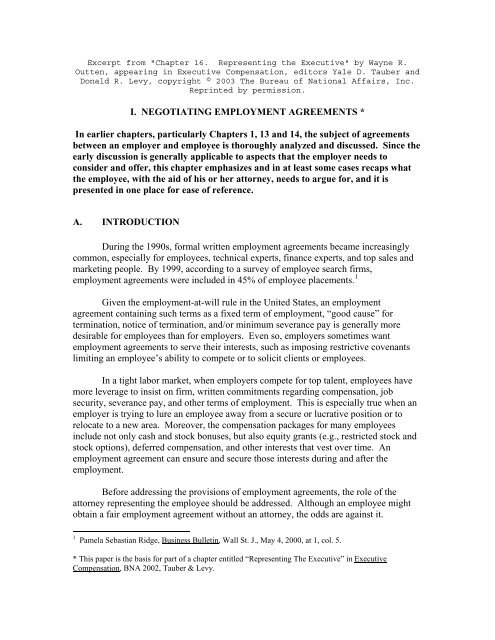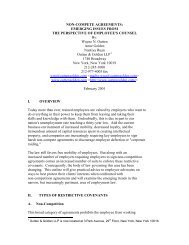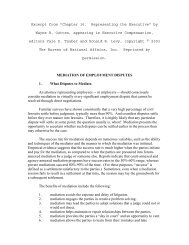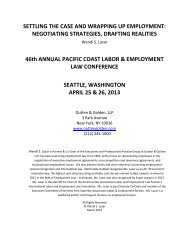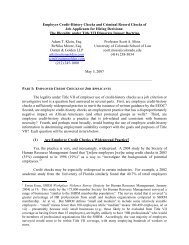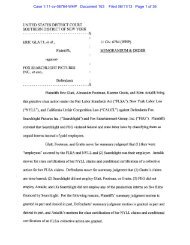I. NEGOTIATING EMPLOYMENT AGREEMENTS * In earlier ...
I. NEGOTIATING EMPLOYMENT AGREEMENTS * In earlier ...
I. NEGOTIATING EMPLOYMENT AGREEMENTS * In earlier ...
You also want an ePaper? Increase the reach of your titles
YUMPU automatically turns print PDFs into web optimized ePapers that Google loves.
Excerpt from "Chapter 16. Representing the Executive" by Wayne R.Outten, appearing in Executive Compensation, editors Yale D. Tauber andDonald R. Levy, copyright © 2003 The Bureau of National Affairs, <strong>In</strong>c.Reprinted by permission.I. <strong>NEGOTIATING</strong> <strong>EMPLOYMENT</strong> <strong>AGREEMENTS</strong> *<strong>In</strong> <strong>earlier</strong> chapters, particularly Chapters 1, 13 and 14, the subject of agreementsbetween an employer and employee is thoroughly analyzed and discussed. Since theearly discussion is generally applicable to aspects that the employer needs toconsider and offer, this chapter emphasizes and in at least some cases recaps whatthe employee, with the aid of his or her attorney, needs to argue for, and it ispresented in one place for ease of reference.A. INTRODUCTIONDuring the 1990s, formal written employment agreements became increasinglycommon, especially for employees, technical experts, finance experts, and top sales andmarketing people. By 1999, according to a survey of employee search firms,employment agreements were included in 45% of employee placements. 1Given the employment-at-will rule in the United States, an employmentagreement containing such terms as a fixed term of employment, “good cause” fortermination, notice of termination, and/or minimum severance pay is generally moredesirable for employees than for employers. Even so, employers sometimes wantemployment agreements to serve their interests, such as imposing restrictive covenantslimiting an employee’s ability to compete or to solicit clients or employees.<strong>In</strong> a tight labor market, when employers compete for top talent, employees havemore leverage to insist on firm, written commitments regarding compensation, jobsecurity, severance pay, and other terms of employment. This is especially true when anemployer is trying to lure an employee away from a secure or lucrative position or torelocate to a new area. Moreover, the compensation packages for many employeesinclude not only cash and stock bonuses, but also equity grants (e.g., restricted stock andstock options), deferred compensation, and other interests that vest over time. Anemployment agreement can ensure and secure those interests during and after theemployment.Before addressing the provisions of employment agreements, the role of theattorney representing the employee should be addressed. Although an employee mightobtain a fair employment agreement without an attorney, the odds are against it.1 Pamela Sebastian Ridge, Business Bulletin, Wall St. J., May 4, 2000, at 1, col. 5.* This paper is the basis for part of a chapter entitled “Representing The Executive” in ExecutiveCompensation, BNA 2002, Tauber & Levy.
<strong>In</strong>variably, the employment agreement will be drafted by the employer’s counsel,typically using a model that the attorney has used for other employers (if the attorney isan outside counsel) or has used for other employees of the employer. <strong>In</strong> any event, thatdocument is rarely balanced or sufficiently protective of the employee’s interests. 2Thus, the employee’s attorney can make a big difference in the negotiation and draftingof the terms and language of the agreement. A qualified attorney can almost always helpan employee get a better, stronger agreement than would otherwise be the case.B. TYPES OF ISSUES COVERED IN <strong>EMPLOYMENT</strong> <strong>AGREEMENTS</strong><strong>In</strong> negotiating employment agreements, two broad categories of issues arise:business and legal. The two categories are not very distinct, and they often overlap. Butthe categories can help in discussing the issues with the client and with opposing counsel.The basic business issues include: the duration of the employment agreement; theemployee’s title, duties, and responsibilities; the basic compensation package (e.g., basesalary, bonuses, commissions, and/or other incentive compensation); the basic benefits(e.g., health insurance, disability and life insurance, and vacation); and specialcompensation arrangements (e.g., stock options, restricted stock, deferred compensation,and supplemental retirement benefits). Other business issues might include “perquisites”(car allowance, club dues, financial counseling, and tax return preparation), a relocationpackage, and expatriate benefits.The basic legal issues include: renewal or extension of any fixed term; groundsfor early termination by the employer (e.g., death, disability, or for “cause”) or theemployee (e.g., for “good reason”); the effect, if any, of a change of control; definitionsof such terms as cause, good reason, and change of control; the effect of early terminationon bonuses, unvested stock, stock options (including the length of time to exercise aftertermination), deferred compensation, and other aspects of compensation and benefits; theamount and type of severance compensation under various scenarios; the nature andscope of restrictive covenants, especially a covenant not to compete; the amount andnature of notices required to be given; dispute resolution (i.e., mediation, arbitration,forum, governing law, etc.); remedies for breach, including injunctive relief, liquidateddamages, and attorneys’ fees and costs; and a broad array of “boilerplate” provisions(e.g., integration clause, warranties and representations, non-waiver clause). Of course,the attorney is responsible for assuring that the language of the final employmentagreement fully, accurately, and clearly sets forth essential terms of the arrangement,whether they are “business” or “legal” terms.2A notable exception is so-called “golden parachute” agreements crafted for the specificpurpose of benefiting senior employees in the event of a change of control. “Stay” orretention bonus agreements are sometimes drafted in a pro-employee manner as well.
Typically, the employee already has negotiated at least the general outlines of thebusiness terms before contacting an attorney. Some employees, however, consult counselbefore beginning such negotiations or early in the process. Early counseling can be veryhelpful in planning the negotiation and structuring the business terms, even with asophisticated client. Generally, the <strong>earlier</strong> the better.Moreover, at such a stage, some employees and their counsel use compensationconsultants. Using publicly available information, survey results, and other informationthat may not be readily available, consultants can advise on the nature and amount ofcompensation and benefits others are getting in the same industry or in comparable typesof businesses. They can be especially helpful in structuring sophisticated equity-basedcompensation packages for senior employees. For example, they can show whatpercentage of the equity of a start-up or early-stage company other CEOs have beengranted in similar situations, or how many stock options they have received. Moreover,consultants sometimes have specialized knowledge in the tax, securities, and ERISAissues that arise in some employee employment agreements.Even when the client consults counsel after negotiating the basic business termscounsel can help the client with business terms, perhaps by suggesting grounds forrenegotiation or by adding new substantive terms not already addressed. Thus, theattorney may stay in the background while advising the client to continue or renewnegotiations with the employer on various business terms. This can be advantageous tothe employee in several ways. First, the employee and the employer are the ones bestable to evaluate and make business decisions about the job. Second, the employee is farbetter able than the attorney to compare and contrast the many aspects of alternative jobprospects. Third, direct discussions between the employee and the employer can helpflush out any areas of actual or potential disagreements about the job, compensation, etc.Fourth, direct discussions can help foster the relationship between the employee and theemployer. Fifth, the employee can sometimes negotiate better business terms directlythan the attorney could, given the more personal connection between the employee andthe employer. And sixth, the employee can keep down attorneys’ fees by engaging indirect negotiations over the business terms.Typically, once the basic business terms are set, the employer’s counsel willprepare and present a proposed employment agreement, which the employee’s counselwill then review. It is at that stage, if not before, that the employee’s attorney focuses onthe legal issues, and perhaps business issues that were not adequately or properly coveredin the negotiations or the proposed agreement. To do that job, the attorney not only mustreview the agreement very carefully, but also must spend some time with the clientdiscussing the nature of the position, the elements of compensation, expectations for thefuture, and how risk averse the client wants to be, etc., in order to understand how best toserve the client’s interests under the agreement. Ultimately, of course, the client has todecide how much he or she wants the job, given the deal offered and the client’salternatives.
The employee’s attorney needs to know what to look for, what the key issues are,what terms and conditions are typical, what the typical range of outcomes is on particularissues, what traps for the unwary exist, and what legal, regulatory, and practicalconstraints apply to certain topics. This outline will try to highlight these issues, withmore emphasis on the legal issues than the business issues.C. BASIC THRESHOLD PROVISIONS1. Term.An employment agreement can have a fixed or indefinite term. <strong>In</strong> many respects,it does not matter which it is. The key issues are (1) under what circumstances can theemployment be terminated and (2) what are the consequences of termination under thevarious circumstances.With a fixed term agreement, the initial consideration is what happens at the endof the term. Under the laws of some states, an employment agreement is automaticallyrenewed either for the period of the initial term or for one year, unless the agreementprovides otherwise. <strong>In</strong> other states, the agreement expires, unless the agreement providesotherwise. <strong>In</strong> any event, the careful attorney should assure that the agreement addressesspecifically what happens at the end of the term.Many agreements have a default provision to the effect that, if neither party givesnotice to the other a certain number of days before the expiration date, the agreement willrenew automatically for another year. Such a provision assures that the agreement staysin effect if neither party remembers or decides to end it. On the other hand, someagreements provide that the agreement will end unless one party gives notice of renewaland the other party does not object within a certain period before expiration. Someagreements provide that the parties agree to discuss in good faith the renewal or extensionof the agreement beginning a certain number of days before expiration.<strong>In</strong> any event, the employee’s attorney should be alert to the consequences for theemployee of a possible expiration of the agreement. For example, if the agreementprovides for severance pay or accelerated vesting of options upon termination withoutcause by the employer during the contract term, what happens to those provisions if theagreement simply expires but the employee keeps working? If the severance and vestingprovisions expire, the employee may lose out on those expected benefits. The solutionmay be a provision that such provisions survive the expiration of the agreement.Fixed term agreements typically provide for early termination under certaincircumstances, such as death, disability, termination by the employer for cause, andtermination by the employee for good reason.Many employment agreements are of indefinite duration, meaning that theycontinue until terminated by death or by action of either party. These agreementssometimes provide that either party can terminate at any time for any reason. Under such
Section 162 (m) of the <strong>In</strong>ternal Revenue Code, which provides that employers cannotdeduct compensation to certain covered employees of publicly-traded companies to theextent that the compensation (including salary and bonuses) exceeds one million dollarsper year. Certain “performance-based” compensation is not, however, subject to the onemillion dollar deduction limit.4. <strong>In</strong>centive Compensation.The amount of incentive compensation and the standards for earning it are,generally, business issues for the employee. Nonetheless, the lawyer often can help theemployee obtain better assurance of full and fair bonuses.Many large companies have incentive compensation plans that outline under whatcircumstances employees earn what bonuses. The employee and the employee’s attorneyshould review carefully any such plans mentioned or relied upon in the employmentagreement, if for no other reason than to make sure the employee understands how theplans work. Moreover, the employee may be able to obtain beneficial clarifications,enhancements, or guarantees under any applicable plans.Proposed employment agreements often provide that incentive compensation willbe in the discretion of the employer. Obviously, that can be quite problematic for theemployee, given that the employer could exercise its discretion to give little or no bonus.For a new employee, this may be an unacceptable risk. Thus, it is often possible tonegotiate a guaranteed or minimum bonus for the first year or two of employment,especially when the employee is leaving behind some bonus pay at the prior employer. 3Moreover, the employee may be able to get the employer to replace adiscretionary or subjective bonus with one based on clear objective goals, whether for theemployee’s own performance, for the employee’s department or division, and/or for thecompany as a whole. For example, such goals might consist of the company or thedepartment achieving a specific increase in share price, a certain level of revenues,profits, or EBITDA (earnings before interest, taxes, depreciation, and amortization), or acertain percentage of budget. Or the goals might pertain to the employee’s own personalperformance, such as a certain number or amount of sales. When such objective goalscannot be set forth in the employment agreement, an alternative is to provide for theemployer and the employee to agree on objective goals before or early in the applicableperiod.Consideration should be given to bonuses for partial years at the beginning or endof the employment. The agreement should make clear how the bonus will be determinedfor the initial year and should address whether the employee will get a full or prorated3 The employee may be able to negotiate a “signing bonus” with the new employer, particularly when theemployee is leaving behind bonus pay or unvested equity interests from the prior employer. Such bonusesare common for jobs, such as investment bankers, in which bonuses constitute a high percentage of theemployee’s total compensation. Sometimes, employers contend that all or part of the signing bonus shouldvest over a period of time or should be forfeited if the employee leaves the new job within a certain periodof time.
onus for the final year, especially if the employee has achieved or largely achievedbonus objectives. The latter subject is typically addressed in the severance pay portion ofthe employment agreement.5. Benefits and Perquisites.The employee should obtain copies of any benefit plans and policies tounderstand how they will apply to the employee. Often, the benefits provision in anemployment agreement will provide simply that the employee will receive the samebenefits as other employees of the same or comparable rank. This may be sufficient, ifthe employee understands generally what those benefits are or will be.Occasionally, particularly when the employer’s benefit plans are not fullydeveloped, the employee may seek to obtain a “most favored nations” clause, assuringthat the employee’s benefits will be at least as good as those of a designated person orgroup of persons.Of course, if the employer has promised any special benefits to the employeebeyond those customarily provided to others, the employment agreement should sospecify. For example, the employee might negotiate more life insurance coverage, moredisability benefits, or more vacation time than is standard. If such arrangements are notset forth in an integrated employment agreement, they may be unenforceable.6. Special Compensation Arrangements.Senior employees often obtain special compensation arrangements, such asdeferred compensation and supplemental employee retirement plans (“SERPs”).Sometimes, these arrangements are set forth in plans applicable to certain employees orcategories of employees, typically the most senior employees.Such plans are non-qualified, meaning that they do not qualify under the <strong>In</strong>ternalRevenue Code for special tax treatment. But they can enable employees to defer thereceipt of compensation – and therefore the payment of income taxes on suchcompensation – until they have left the employer, perhaps upon retirement, when theemployee’s income and tax rates probably will be lower. Such deferred compensationamounts typically accrue earnings and/or appreciation until paid out.The employee should be aware, however, that to avoid current taxation, thedeferred compensation must remain a liability of the employer (as further discussed inChapter 4). This is true whether or not the employer sets aside funds currently to meet itsfuture obligations (e.g., places funds into a “rabbi trust”). <strong>In</strong> either situation, theemployee will be merely an unsecured creditor of the employer.
A deferred compensation arrangement need not be set up or governed by a plan ofgeneral applicability. It may be created by an employment agreement for a particularemployee. Like a deferred compensation plan, such a deferred compensationarrangement is simply a contractual commitment by the employer to make certainpayments at certain times in the future.Notably, deferred compensation may be subject to vesting and forfeitureprovisions. Thus, an employee who quits or is fired for cause may not get all or part ofthe deferred compensation. The employee’s attorney should try to obtain protectionagainst such potential loss by providing in the agreement for accelerated or continuedvesting under appropriate circumstances.D. EQUITY-BASED COMPENSATIONMany employment agreements include equity-based compensation, such asrestricted stock, stock options, phantom stock, and stock appreciation rights (SARs), asfurther described in Chapter 3. These arrangements are used by employers for two basicpurposes: to provide “handcuffs” to keep employees from leaving before the vesting ofequity interests and to provide an incentive for performance by rewarding employees forfuture appreciation in the price of the employer’s stock, whether privately held orpublicly traded. Equity-based compensation raises many complex legal, tax, securities,and accounting issues that are beyond the scope of this chapter; here are some highlights.Equity-based compensation is often the key attraction for an employee to join andstay with a particular employer. <strong>In</strong>deed, some employees give up secure positions withgood pay to accept jobs at lower rates of pay – but with the opportunity to participate inanticipated increases in the company’s stock price. This phenomenon has been commonat start-ups and emerging companies, especially those with a realistic chance of an initialpublic offering (IPO) in the foreseeable future.Stock options are a common form of equity-based compensation. <strong>In</strong>centive stockoptions (ISOs) meet certain requirements under the <strong>In</strong>ternal Revenue Code and thereforereceive favorable tax treatment. Non-qualified stock options (NQOs) do not receivefavorable tax treatment but are not subject to the restrictions that are applicable to ISOsunder the <strong>In</strong>ternal Revenue Code. For example, when an employee exercises an ISO(i.e., buys the stock at the exercise or strike price set when the ISO was granted), theemployee does not recognize any taxable gain on the difference between the exerciseprice and the fair market value at the time of exercise. The employee pays taxes onlywhen the stock is sold at a profit. Moreover, if the employee holds the stock for morethan two years after the date of the option grant and more than one year after the exercisedate, any profit upon sale will be taxed as a long-term capital gain, not as ordinaryincome. With an NQO, on the other hand, the employee will recognize a taxable gain tothe extent that the fair market value exceeds the exercise price at the time of exercise(even if the employee does not sell the stock then) and the gain is taxed as ordinaryincome; even so, any appreciation in the value of the stock between the date of exercise
and the date of sale will receive capital gains treatment. Among the restrictions on ISOsare: the exercise price cannot be lower than 100% of the fair market value on the date theoption was granted 4 ; the maximum amount in which any employee can vest is $100,000worth of options per year (determined at the time of grant); and the term of the optioncannot exceed ten years.Phantom stock and SARs are not really stock at all. The employee owns no stockand has no voting rights as a stockholder. Rather, the employee is entitled to payment(typically in cash, though sometimes in stock) based on the price of the employer’s stock(phantom stock) or the appreciation in the price of the employer’s stock (SARs) duringthe relevant period.The employee and the employee’s attorney should obtain and review whateverplans govern any stock grants, stock options, phantom stock, and other equity-basedcompensation. Notably, equity-based compensation grants do not require formal plans –they could be creatures of contract — though they usually are set forth in one or moreplan documents. When a plan sets forth the general terms of an equity-based vehicle, aseparate agreement is usually prepared and executed at the time of the initial grant andeach subsequent grant, in which the terms of the particular grant are set forth.The employee’s attorney should compare the terms of the stock plan, theagreement pertaining to each grant, and the terms of the employment agreement to assureconsistency. Any differences should be clarified. It may be advisable in certaincircumstances to insert language into the employment agreement stating that the terms ofthat agreement prevail over any inconsistent terms in the grant agreement or in theunderlying plan document; sometimes, negotiation over such provisions may lead tochanges in the grant agreement or even the plan itself.The employee and the employee’s attorney should focus very closely on thevesting of equity grants. For the employee, the faster the vesting the better. For theemployer, on the other hand, slower vesting is preferable; unvested shares and optionscan provide “handcuffs” to keep employees from departing when the employer wantsthem to stay, particularly when unvested options are “in the money” (i.e., the currentstock price is higher than the exercise price). Typically, stock grants and options vestratably over time, usually one to five years. Such vesting might be annually, quarterly, ormonthly; generally, employees benefit from the shorter intervals of vesting. The vestingof some options (i.e., performance-based options) is based not on the passage of time buton the achievement of certain goals, such as a certain level of financing or revenues.Generally, the employee or the employee’s lawyer should try to negotiate accelerated orcontinued vesting of all unvested stock and stock options if the employer terminates theemployment without cause or the employee quits for good reason. As a fallback, theymay be able to obtain accelerated or continued vesting for some period, say one yearfrom the date of termination.4 For ten percent shareholders, the exercise price must be at least 110% of the fair market value at the timeof the option grant.
The period for exercise of vested options after termination of employment alsoshould be examined. Some option agreements and employment agreements provide thatan employee’s vested options expire immediately upon termination for cause orresignation without good reason and expire within a short period (say, 30 or 90 days)after termination for other reasons. Obviously, such provisions can jeopardize theemployee’s ability to realize a gain on the options if the options expire before they can beexercised or if the options are “under water” (i.e., the exercise price exceeds the currentstock price) during the shortened exercise period. The solution is to try to obtain at leasta modest period (say, 30 days) to exercise even in the event of termination for cause orresignation without good reason, and an ample period (say, 90 days to a year) to exercisein other circumstances. It is common to provide a lengthy period for the estate of adeceased employee to exercise after termination of employment due to death.The employee’s attorney should also consider “tag-along” and “drag-along” rightsin certain situations. Basically, with a tag-along right, the employee-shareholder has a“put” – a right to force the purchase of his or her equity interest – if a majorityshareholder sells its interest. By contrast, under a drag-along right, a majorityshareholder has a “call” – a right to force the employee-shareholder to sell – if themajority shareholder sells its interest.E. TERMINATION AND SEVERANCE PROVISIONSGenerally, these are among the most important provisions in an employmentagreement. For a fixed-term contract, these provisions govern early termination of theagreement. For an indefinite term contract, these provisions govern when and how theterm of the agreement will end. Moreover, the severance provisions govern what theemployee will get under various scenarios.The employer’s proposed employment agreement typically will address thefollowing grounds for termination of the term of the agreement: death, disability,retirement, and termination by the employer for cause. <strong>In</strong> addition, the employee’sattorney should try to add termination by the employee for good reason.Employment agreements typically provide that, when the employee dies, theemployer’s only obligation under the agreement is to pay to the employee’s estate anyaccrued salary and accrued unused vacation pay. The employee’s attorney may try to addpayment of any accrued but unpaid bonus and a prorated bonus for the final year ofemployment. The agreement may also provide for a specified amount of life insurancecoverage.The issues relating to termination and payments upon disability are similar tothose relating to termination and payments upon death, except that the employee may beentitled to certain disability benefits after termination, which may include continuedvesting of equity interests. Moreover, employees often can obtain continuation of certainbenefits, particularly health insurance, at the employer’s expense for some period after
termination due to disability. The employment agreement should contain a definition of“disability”. From the employee’s perspective, the definition should be fairly stringent,so the employer cannot terminate the employee too readily. The typical definition ofdisability provides that the employee will be deemed disabled after a certain number ofconsecutive days (e.g., 90 days) of inability to perform the job and/or after a certainnumber of days within a set period (e.g., 180 days during a one-year period). Thelanguage should be crafted to assure that the termination date does not occur until the endof the relevant period, even if the parties know before then that the employee will not beable to return to work.Retirement is generally treated the same as death, except that the employee maybe entitled to certain retiree benefits after termination, which may include continuedvesting of equity interests. Moreover, employees often can obtain continuation ofbenefits, particularly health insurance, at the employer’s expense.The employee’s attorney should focus very intently on the provisions concerningtermination by the employer for cause. They can have a major impact on the employee’srights upon termination to salary, benefits, severance pay, and vesting of deferredcompensation and equity interests. <strong>In</strong> short, the attorney should try to make the definitionof “cause” as narrow as possible. Typical elements of cause include: conviction of afelony or other crime involving moral turpitude; loss or suspension of any necessarylicenses; breach of company policies; failure or refusal to perform the duties of the job;insubordination; and breach of contract by the employee. For each of these, theemployee’s attorney should seek to include, to the extent applicable, qualifiers regardingthe employee’s state of mind and the nature and extent of the employee’s conduct. Thus,for example, words like “material” or “substantial” should be inserted before nouns like“breach” and words like “willful,” “intentional,” “knowing,” “repeated” or “persistent”should be inserted before nouns like “breach” and “failure.” Of course, the employee’sattorney should resist vigorously an employer’s efforts to include words like “discretion”and “satisfaction” that give the employer too much room for discretionary and subjectivedecisions.The employee and the employee’s attorney should try to obtain the ability of theemployee to resign for a good reason, with such a termination being treated like atermination by the employer without cause – similar to constructive discharge. Such“good reasons” might include: a material diminution in the employee’s title, duties,responsibilities, authority, compensation, or benefits; a requirement to relocate beyond acertain area; the employer’s breach of the contract; or a “change of control.” A “changeof control” definition might include: a merger or sale of a majority of the company’sstock; sale or transfer of all or substantially all of the company’s assets; a major change inthe composition of the board of directors; or the departure of a designated person as acontrolling shareholder, board member, board chair, CEO, etc.The employee and the employee's attorney should try to obtain a provisionrequiring the employer, before terminating for cause, to give the employee adequatewritten notice of the proposed action and a reasonable opportunity to cure. Such a
provision need not apply to grounds that are not curable (e.g., conviction of a felony) butare especially appropriate for grounds that are curable and somewhat subjective, such asfailure to perform or breach of contract. The notice should identify the specificprovision(s) of the cause definition being relied upon and should describe with specificitythe conduct of the employee that is the basis for the proposed termination. The cureperiod may be described as “reasonable,” but a specific ample period of time (say, 30days) is preferable to avoid dispute. A cure provision serves not only to provideinformation and protection for the employee but also to limit rash and arbitrary conductby the employer.The employee’s attorney should also be aware of the punitive excise taxesimposed on certain “golden parachutes” that are triggered by a change of control. SeeIRC §§ 280G and 4999.F. RESTRICTIVE COVENANTSBooks can be and have been written about the many types of restrictive covenantsthat employers include in employment agreements, severance agreements, and otheragreements with employees. Such restrictive covenants include confidentiality and nondisclosureagreements and agreements not to compete or to solicit clients and employees.A discussion of such agreements is beyond the scope of this chapter. For furtherinformation, see Covenants Not to Compete: A State by State Survey (ABA, published byBNA).The employee’s attorney should be conversant with the case law (and any relevantstatutes) regarding restrictive covenants in applicable jurisdictions. This is especiallyimportant regarding a state’s policy and law on the enforceability of non-competeclauses. Such laws varying considerably state-by-state.Obviously, the employee’s counsel will try to make any such covenants as narrowand reasonable as possible. Generally, fairly broad confidentiality and non-disclosureagreements are not objectionable; in fact, some of the strictures contained in suchagreements may exist as a matter of law anyway. Moreover, in most contexts, employeesdo not object to broad agreements providing for the employer’s ownership of anycopyrights, patents, etc., arising out of or during the employment relationship. Thus,except in special circumstances, little energy needs to be focused on such provisions.Usually, the main concerns of the employee pertain to non-competition and nonsolicitationclauses, which can seriously limit the employee’s ability to earn a living afterleaving the employer. Such provisions have become common, as employers seek to limitcompetition and protect their confidential, proprietary, and trade secret information. Theemployee and the employee’s counsel should focus carefully on the language proposed,evaluate how that language, if enforced, might affect the employee’s post-employmentability to work, and then negotiate for narrower, clearer, and fewer limits. For example,
generally a non-compete clause should not prevent the employee from working for acompetitor of the employer if the employee’s own activities are not competitive.One area for possible focus is the impact of the grounds for termination on thenon-compete clause. The employee may negotiate for a provision that, if theemployment is terminated by the employer without cause or by the employee for goodreason, then the noncompete clause does not apply, or it applies for a shorter period orwith a narrower scope.Moreover, the duration of the non-compete period can be linked to severance pay.For example, the employer or the employee may have the option to shorten the noncompeteperiod by ceasing or waiving severance payments.G. DISPUTE RESOLUTIONA comprehensive employment agreement should include a dispute resolutionprovision setting forth what forum will address any disputes that arise under theagreement. For further discussion, see the discussion in Section III of this chapter and seeChapter 14, also dealing with alternative dispute resolution procedures.Although mandatory arbitration of statutory discrimination cases is abhorrent toemployees’ attorneys, arbitration of contractual disputes is not. <strong>In</strong>deed, arbitration ofcontractual disputes has many relative advantages for employees, including speed, cost,and finality. Consider suggesting such a provision if the employer does not include onein the initial draft.Moreover, it is a good idea for the dispute resolution provision to have threesteps:1. good faith discussions for a reasonable but short period;2. mediation using an agreed upon (preferably named) mediator or meditaionprovider;3. arbitration using a named arbitrator or arbitration provider (such as theAmerican Arbitration Association, JAMS, or CPR <strong>In</strong>stitute for Dispute Resolution).Of course, the parties could agree to engage in the first two steps (and even the third)once a dispute has arisen, but including such a provision in the agreement may helpinitiate early discussions and possible early resolution of the dispute.The initial issue to address in the dispute resolution provision is its scope. Does itapply to disputes arising under or relating to the agreement only or to all disputes arisingout of or relating to the employment relationship, including the termination of thatrelationship? The latter language is much broader and would encompasses statutory andtort claims as well as contract disputes.Another issue is location. Employers’ standard agreements sometimes providefor any mediation or arbitration to take place in the jurisdiction of the company’s
headquarters or a regional office. For the employee, the preferred site is near theemployee’s workplace or home.Dispute resolution provisions sometimes are silent on who pays for mediation orarbitration; sometimes, they provide for equal contributions. Of course, the employeegenerally prefers for the employer to bear all or most of the cost of such proceedings. <strong>In</strong>any event, it is advisable to include a statement that the arbitrator may or shall awardcosts and expenses to the prevailing party.<strong>In</strong> addition, try to include a provision that the arbitrator has the authority to awardattorneys’ fees to the prevailing party. Absent such a provision, arbitrators generally lackthe authority to award attorneys’ fees to a prevailing party in a contract dispute, whichdisadvantages employees relative to employers. On the other hand, a provision requiringthe arbitrator to award attorneys’ fees to a prevailing party could present a risk that theemployee may have to pay the employer’s attorneys’ fees. The best balance foremployees is to enable but not require the arbitrator to make such an award.Other issues include the number of arbitrators (one or three), which states lawgoverns, and what rules govern. If the AAA is the arbitration provider, its National Rulesfor the Resolution of Employment Disputes should apply.H. MISCELLANEOUSBoilerplate provisions at the end of employment agreements typically addresssome of the following subjects: remedies (including availability of injunctive relief andliquidated damages), governing law, successors and assigns (binding and benefitingsuccessors of both employer and employee), integration and merger, severability, andsurvival of certain rights.<strong>In</strong> special circumstances, employees should seek an assurance of performance ofsome or all obligations under the agreement from someone other than the employingorganization. This could be a personal guarantee by a major shareholder or anendorsement or guarantee by a corporate parent or affiliate. Such an assurance isespecially important when the employing organization is new, struggling, or thinlycapitalized.Last but not least, the employee’s attorney should try to obtain the employer’scommitment to pay the reasonable attorneys’ fees incurred by the employee fornegotiating the agreement, perhaps with a cap on the amount.


